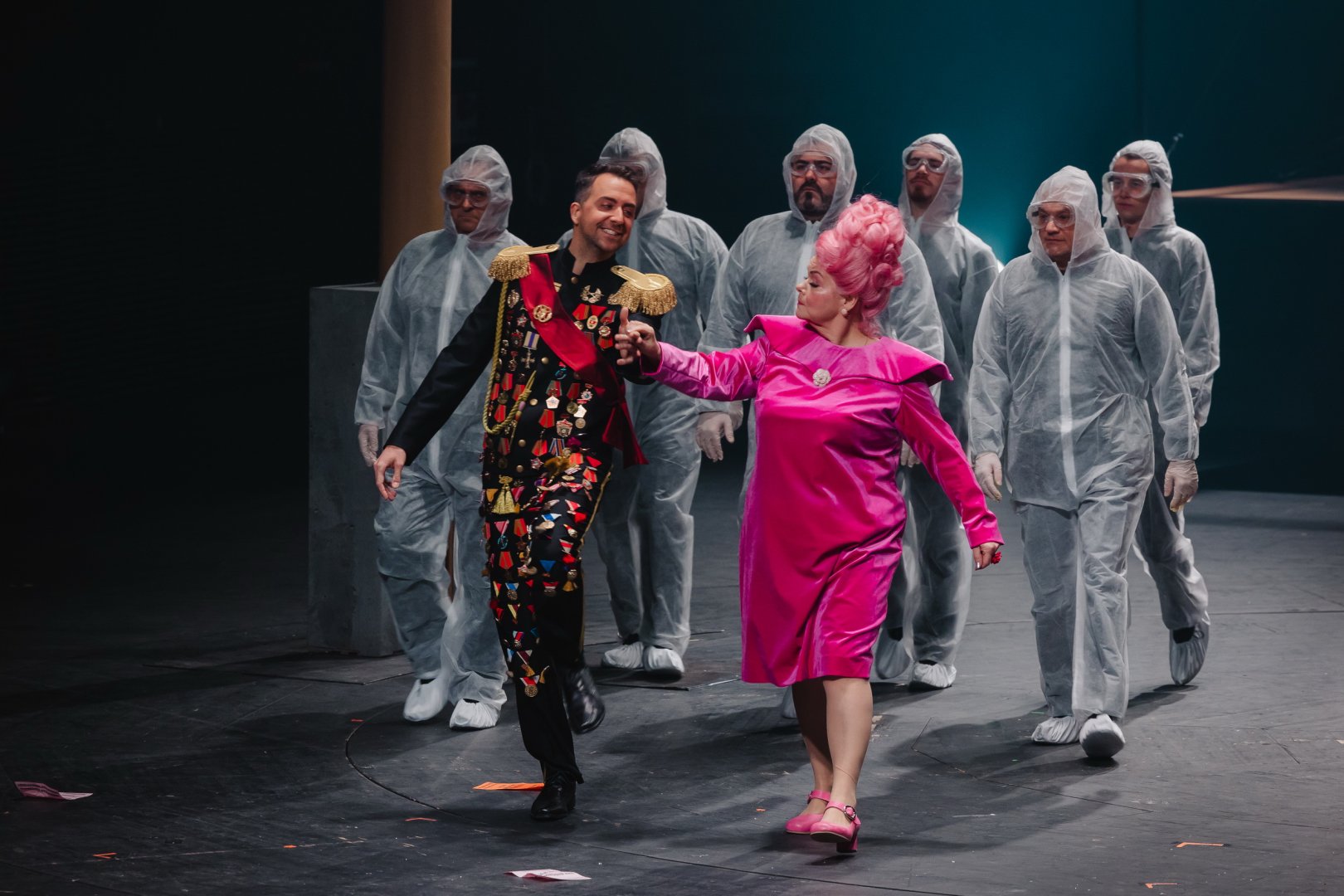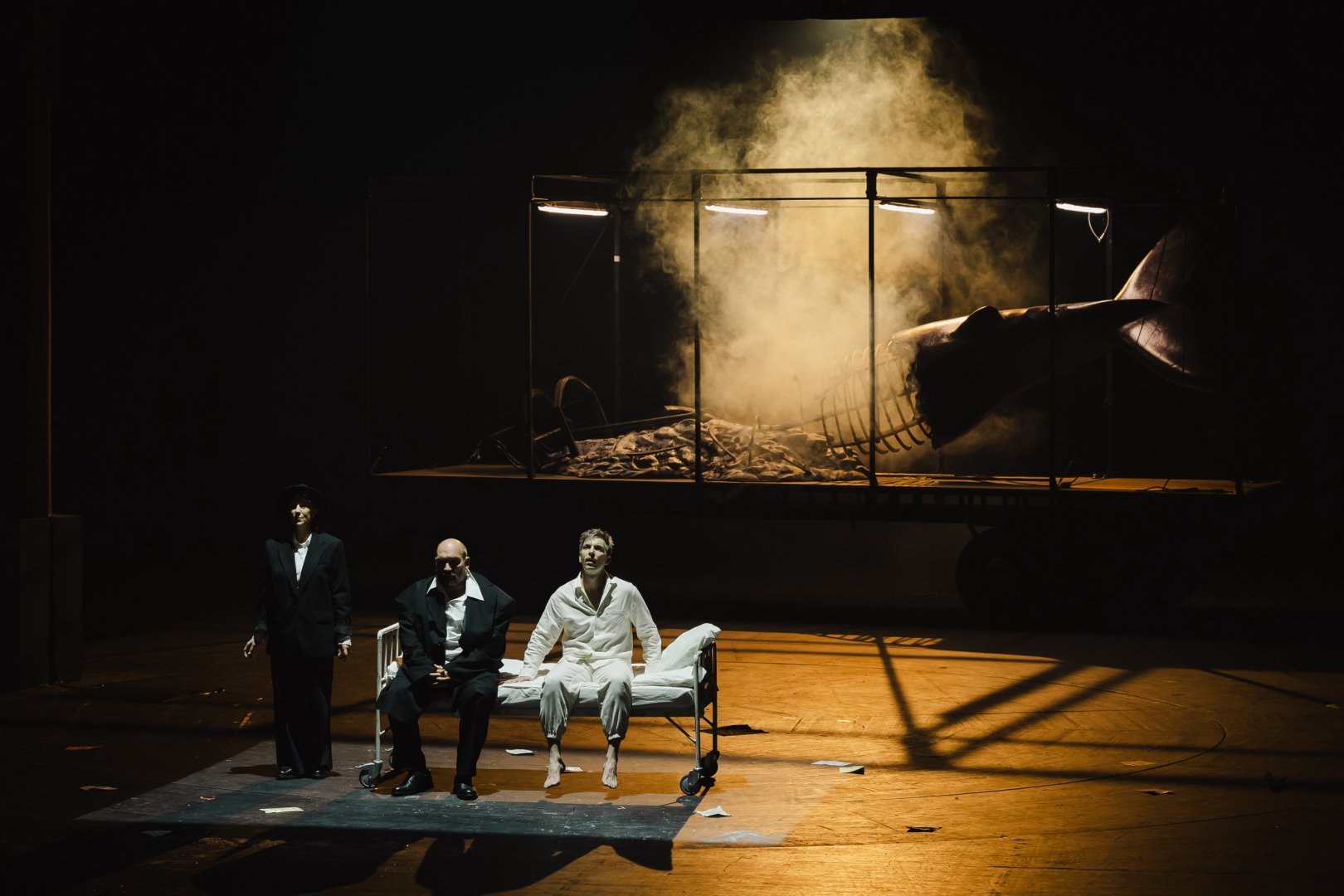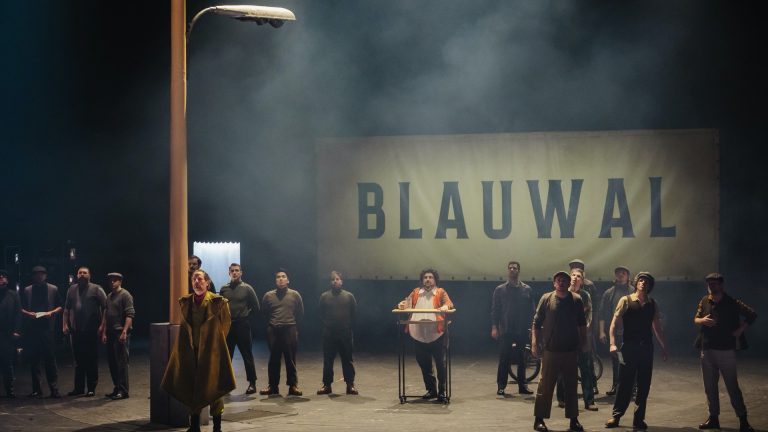Péter Eötvös’s latest opera “Valuska” is a stunning enactment of László Krasznahorkai’s 1989 novel “The Melancholy of Resistance” wherein the lone voice of a misunderstood and publicly mocked individual is the affective focal point in a destructive and dystopian society. The Hungarian State Opera commissioned the one-act work in 2018, using a libretto by Mari Mezei and Kinga Keszthelyi. The work had its world premiere in the Eiffel Art Studios on December 2nd, and performances continued through the 17th.
The inspired visual and musical effects of this production illuminated, with minimal sets and props, clever satirical descriptions of archetypes within a society divorced from three-dimensional thought. The protagonist, János Valuska, was infatuated with astronomy and man’s position in the universe, while the rest of the crowd was concerned with achieving power and attention. These philosophical and societal facets were reflected by the imaginative onstage visual life created by the production/tech teams and director Bence Varga. And Eötvös’ orchestral genius delivered a firm underpinning for the narrative’s essential meaning. Kálmán Szennai conducted the Hungarian State Opera Orchestra in the challenging score with precision and energy.
The story begins on a train that’s on its way to see a travelling circus that features a novel centerpiece: a giant blue whale. The event is masterminded by a mysterious three-eyed prince whom no one ever sees, and whose comments are quoted in fractured sentences by his aide. The main personalities that dominate the host-village’s square include the so-called half-wit Valuska, his mother Mrs. Pflaum, a disheartened retired professor and his ambitious wife Tünde who schemes to be the mayor, a soldier, an officer, and three drunk men physically anchored to their pub tables on wheels. The proverbial elephant in the room is a giant truck that carries the world’s largest blue whale, which is yet to be unveiled to the unwitting crowd. (Much later, we see the actual contents in the truck – a whale skeleton whose midsection is a pile of rubble.)

Zsolt Haja, in the role of Valuska, gave a heart-rending performance as the only human with a soul in a chaotic circus of cartoonish characters fighting against an unseen enemy as well as each other. In certain ways, the plot echoes Ionescu’s “Rhinoceros” – a 20th century masterpiece of propaganda exposé. Eötvös corroborates this in his comments in the opera company’s program booklet:
“I see the emphasis in the conflict between the crowd and the individual, as well as in the growing manipulation from the background typical of our age worldwide. The technique of manipulation is highly developed; it can subtly drive the masses to most astonishing acts.”
The orchestral score is a splendid tapestry of sonic effects that match the characters’ behavioral and vocal languages, and set the tone for the many mood-shifts and physical set changes. The vocalism required for the cast was also challenging in its improvisational quality, resembling extended recitatives, that still made emotional sense. The longest singing moment was that of Valuska, as he poignantly and sweetly sang his cosmological thoughts while the rest of the inhabitants were vandalizing the village. When his mother dies face-down in the fracas, the only response from anyone was “Move along. Nothing to see here.”
“Written at a time when the Eastern Bloc was undergoing major social unrest, [Krasznahorkai’s] book is a political allegory,” states Wikipedia. “[It] can be taken for totalitarian ideology which had been pushed on Hungary from the outside. Likewise, the villainous Mayoress Tünde who controls the town under the auspices of fighting off the mysterious combatants is, in herself, a criticism of totalitarian ideology as much as the people she uses to attain power.” (This story was also the basis for Béla Tarr’s 2000 film, “Werckmeister Harmonies.”) Poor Valuska is subsequently locked up in an insane asylum as he was declared to be of no consequence in the midst of the looting and arson. Eötvös, though, gives him the last word in his pronouncement at the opera’s close:
“There will be no more snow.”
Coloratura soprano Tünde Szabóki excelled as the self-appointed mayor with her stratospheric tessitura, and soprano Adrienne Miksch was duly affecting in the role of Mrs. Pflaum, whose wig resembled Margaret Thatcher’s hair style. As a peasant lady, soprano Mária Farkasréti delivered lots of vocal punch in her gutsy characterization, Attila Erdős portrayed a woozy, loose-legged officer with comic flair, and András Hábetler perfectly portrayed the professor who dons more and more shoulder padding to bolster his deflating ego.

The comedic trio of beer-drinkers (Lőrinc Kosa, András Kiss, János Szerekován), and István Horváth as the circus director exhibited excellent singing, as did the seven-member male chorus. The sonorous speaking voice of Tünde Szalontay added more vocal gravitas as the Narrator, and the richly-inspired costumes by Kató Huszár provided delicious eye candy to the apocalyptic circus.
Addendum: the only negative aspect for this attendee was the use of copious amounts of stage smoke (to create a misty effect), which left my throat burning, during and after the performance. I wonder how this affects the singers, who have to breathe these artificial clouds.











